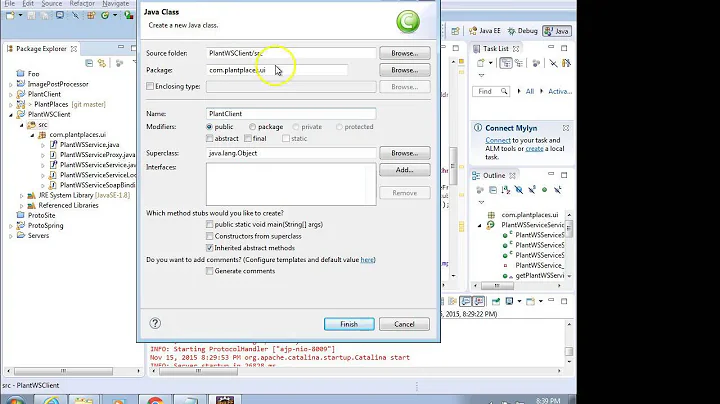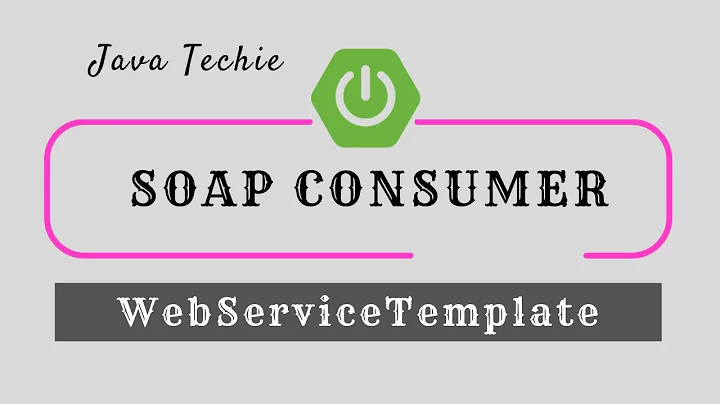How to do a SOAP Web Service call from Java class?
Solution 1
I understand your problem boils down to how to call a SOAP (JAX-WS) web service from Java and get its returning object. In that case, you have two possible approaches:
- Generate the Java classes through
wsimportand use them; or - Create a SOAP client that:
- Serializes the service's parameters to XML;
- Calls the web method through HTTP manipulation; and
- Parse the returning XML response back into an object.
About the first approach (using wsimport):
I see you already have the services' (entities or other) business classes, and it's a fact that the wsimport generates a whole new set of classes (that are somehow duplicates of the classes you already have).
I'm afraid, though, in this scenario, you can only either:
- Adapt (edit) the
wsimportgenerated code to make it use your business classes (this is difficult and somehow not worth it - bear in mind everytime the WSDL changes, you'll have to regenerate and readapt the code); or - Give up and use the
wsimportgenerated classes. (In this solution, you business code could "use" the generated classes as a service from another architectural layer.)
About the second approach (create your custom SOAP client):
In order to implement the second approach, you'll have to:
- Make the call:
- Use the SAAJ (SOAP with Attachments API for Java) framework (see below, it's shipped with Java SE 1.6 or above) to make the calls; or
- You can also do it through
java.net.HttpUrlconnection(and somejava.iohandling).
- Turn the objects into and back from XML:
- Use an OXM (Object to XML Mapping) framework such as JAXB to serialize/deserialize the XML from/into objects
- Or, if you must, manually create/parse the XML (this can be the best solution if the received object is only a little bit differente from the sent one).
Creating a SOAP client using classic java.net.HttpUrlConnection is not that hard (but not that simple either), and you can find in this link a very good starting code.
I recommend you use the SAAJ framework:
SOAP with Attachments API for Java (SAAJ) is mainly used for dealing directly with SOAP Request/Response messages which happens behind the scenes in any Web Service API. It allows the developers to directly send and receive soap messages instead of using JAX-WS.
See below a working example (run it!) of a SOAP web service call using SAAJ. It calls this web service.
import javax.xml.soap.*;
public class SOAPClientSAAJ {
// SAAJ - SOAP Client Testing
public static void main(String args[]) {
/*
The example below requests from the Web Service at:
https://www.w3schools.com/xml/tempconvert.asmx?op=CelsiusToFahrenheit
To call other WS, change the parameters below, which are:
- the SOAP Endpoint URL (that is, where the service is responding from)
- the SOAP Action
Also change the contents of the method createSoapEnvelope() in this class. It constructs
the inner part of the SOAP envelope that is actually sent.
*/
String soapEndpointUrl = "https://www.w3schools.com/xml/tempconvert.asmx";
String soapAction = "https://www.w3schools.com/xml/CelsiusToFahrenheit";
callSoapWebService(soapEndpointUrl, soapAction);
}
private static void createSoapEnvelope(SOAPMessage soapMessage) throws SOAPException {
SOAPPart soapPart = soapMessage.getSOAPPart();
String myNamespace = "myNamespace";
String myNamespaceURI = "https://www.w3schools.com/xml/";
// SOAP Envelope
SOAPEnvelope envelope = soapPart.getEnvelope();
envelope.addNamespaceDeclaration(myNamespace, myNamespaceURI);
/*
Constructed SOAP Request Message:
<SOAP-ENV:Envelope xmlns:SOAP-ENV="http://schemas.xmlsoap.org/soap/envelope/" xmlns:myNamespace="https://www.w3schools.com/xml/">
<SOAP-ENV:Header/>
<SOAP-ENV:Body>
<myNamespace:CelsiusToFahrenheit>
<myNamespace:Celsius>100</myNamespace:Celsius>
</myNamespace:CelsiusToFahrenheit>
</SOAP-ENV:Body>
</SOAP-ENV:Envelope>
*/
// SOAP Body
SOAPBody soapBody = envelope.getBody();
SOAPElement soapBodyElem = soapBody.addChildElement("CelsiusToFahrenheit", myNamespace);
SOAPElement soapBodyElem1 = soapBodyElem.addChildElement("Celsius", myNamespace);
soapBodyElem1.addTextNode("100");
}
private static void callSoapWebService(String soapEndpointUrl, String soapAction) {
try {
// Create SOAP Connection
SOAPConnectionFactory soapConnectionFactory = SOAPConnectionFactory.newInstance();
SOAPConnection soapConnection = soapConnectionFactory.createConnection();
// Send SOAP Message to SOAP Server
SOAPMessage soapResponse = soapConnection.call(createSOAPRequest(soapAction), soapEndpointUrl);
// Print the SOAP Response
System.out.println("Response SOAP Message:");
soapResponse.writeTo(System.out);
System.out.println();
soapConnection.close();
} catch (Exception e) {
System.err.println("\nError occurred while sending SOAP Request to Server!\nMake sure you have the correct endpoint URL and SOAPAction!\n");
e.printStackTrace();
}
}
private static SOAPMessage createSOAPRequest(String soapAction) throws Exception {
MessageFactory messageFactory = MessageFactory.newInstance();
SOAPMessage soapMessage = messageFactory.createMessage();
createSoapEnvelope(soapMessage);
MimeHeaders headers = soapMessage.getMimeHeaders();
headers.addHeader("SOAPAction", soapAction);
soapMessage.saveChanges();
/* Print the request message, just for debugging purposes */
System.out.println("Request SOAP Message:");
soapMessage.writeTo(System.out);
System.out.println("\n");
return soapMessage;
}
}
About using JAXB for serializing/deserializing, it is very easy to find information about it. You can start here: http://www.mkyong.com/java/jaxb-hello-world-example/.
Solution 2
Or just use Apache CXF's wsdl2java to generate objects you can use.
It is included in the binary package you can download from their website. You can simply run a command like this:
$ ./wsdl2java -p com.mynamespace.for.the.api.objects -autoNameResolution http://www.someurl.com/DefaultWebService?wsdl
It uses the wsdl to generate objects, which you can use like this (object names are also grabbed from the wsdl, so yours will be different a little):
DefaultWebService defaultWebService = new DefaultWebService();
String res = defaultWebService.getDefaultWebServiceHttpSoap11Endpoint().login("webservice","dadsadasdasd");
System.out.println(res);
There is even a Maven plug-in which generates the sources: https://cxf.apache.org/docs/maven-cxf-codegen-plugin-wsdl-to-java.html
Note: If you generate sources using CXF and IDEA, you might want to look at this: https://stackoverflow.com/a/46812593/840315
Solution 3
Might help for someone who have xml request as string.
if you have WSDL, You can create a new soap request in SoapUI with that WSDL file.
It would automatically generate the Structure/XML for input request.
Here is some simple version of Java code you can use to call Soap service if you have the input request xml from SoapUI:
import java.io.BufferedReader;
import java.io.DataOutputStream;
import java.io.FileInputStream;
import java.io.FileNotFoundException;
import java.io.FileOutputStream;
import java.io.IOException;
import java.io.InputStream;
import java.io.InputStreamReader;
import java.net.HttpURLConnection;
import java.net.URL;
public class SimpleSoapClient {
public static void main(String args[]) throws IOException {
String address="Hyderabad";
/* place your xml request from soap ui below with necessary changes in parameters*/
String xml="<soapenv:Envelope xmlns:soapenv=\"http://schemas.xmlsoap.org/soap/envelope/\" xmlns:ws=\"http://www.YourUrlAsPerWsdl.com/\">\r\n" +
" <soapenv:Header/>\r\n" +
" <soapenv:Body>\r\n" +
" <ws:callRest>\r\n" +
" <name>"+"Hello"+"</name>\r\n" +
" <address>"+address+"</address>\r\n" +
" </ws:callRest>\r\n" +
" </soapenv:Body>\r\n" +
"</soapenv:Envelope>";
String responseF=callSoapService(xml);
System.out.println(responseF);
}
}
static String callSoapService(String soapRequest) {
try {
String url = "https://gogle.com/service/hello"; // replace your URL here
URL obj = new URL(url);
HttpURLConnection con = (HttpURLConnection) obj.openConnection();
// change these values as per soapui request on top left of request, click on RAW, you will find all the headers
con.setRequestMethod("POST");
con.setRequestProperty("Content-Type","text/xml; charset=utf-8");
con.setDoOutput(true);
DataOutputStream wr = new DataOutputStream(con.getOutputStream());
wr.writeBytes(soapRequest);
wr.flush();
wr.close();
String responseStatus = con.getResponseMessage();
System.out.println(responseStatus);
BufferedReader in = new BufferedReader(new InputStreamReader(
con.getInputStream()));
String inputLine;
StringBuffer response = new StringBuffer();
while ((inputLine = in.readLine()) != null) {
response.append(inputLine);
}
in.close();
// You can play with response which is available as string now:
String finalvalue= response.toString();
// or you can parse/substring the required tag from response as below based your response code
finalvalue= finalvalue.substring(finalvalue.indexOf("<response>")+10,finalvalue.indexOf("</response>")); */
return finalvalue;
}
catch (Exception e) {
return e.getMessage();
}
}
}
Solution 4
I found a much simpler alternative way to generating soap message. Given a Person Object:
import com.fasterxml.jackson.annotation.JsonInclude;
@JsonInclude(JsonInclude.Include.NON_NULL)
public class Person {
private String name;
private int age;
private String address; //setter and getters below
}
Below is a simple Soap Message Generator:
import com.fasterxml.jackson.databind.DeserializationFeature;
import com.fasterxml.jackson.databind.ObjectMapper;
import com.fasterxml.jackson.databind.SerializationFeature;
import com.fasterxml.jackson.datatype.jsr310.JavaTimeModule;
import lombok.extern.slf4j.Slf4j;
import org.apache.commons.lang3.StringUtils;
import com.fasterxml.jackson.dataformat.xml.XmlMapper;
@Slf4j
public class SoapGenerator {
protected static final ObjectMapper XML_MAPPER = new XmlMapper()
.enable(DeserializationFeature.READ_UNKNOWN_ENUM_VALUES_AS_NULL)
.configure(DeserializationFeature.FAIL_ON_UNKNOWN_PROPERTIES, false)
.configure(SerializationFeature.WRITE_DATES_AS_TIMESTAMPS, false)
.registerModule(new JavaTimeModule());
private static final String SOAP_BODY_OPEN = "<soap:Body>";
private static final String SOAP_BODY_CLOSE = "</soap:Body>";
private static final String SOAP_ENVELOPE_OPEN = "<soap:Envelope xmlns:soap=\"http://schemas.xmlsoap.org/soap/envelope/\">";
private static final String SOAP_ENVELOPE_CLOSE = "</soap:Envelope>";
public static String soapWrap(String xml) {
return SOAP_ENVELOPE_OPEN + SOAP_BODY_OPEN + xml + SOAP_BODY_CLOSE + SOAP_ENVELOPE_CLOSE;
}
public static String soapUnwrap(String xml) {
return StringUtils.substringBetween(xml, SOAP_BODY_OPEN, SOAP_BODY_CLOSE);
}
}
You can use by:
public static void main(String[] args) throws Exception{
Person p = new Person();
p.setName("Test");
p.setAge(12);
String xml = SoapGenerator.soapWrap(XML_MAPPER.writeValueAsString(p));
log.info("Generated String");
log.info(xml);
}
Related videos on Youtube
jpz
Updated on July 08, 2022Comments
-
jpz almost 2 years
I'm relative new to the webservices world and my research seems to have confused me more than enlighten me, my problem is that I was given a library(jar) which I have to extend with some webservice functionality.
This library will be shared to other developers, and among the classes in the jar will be classes that have a method which calls a webservice (that essentially sets an attribute of the class, does some business logic, like storing the object in a db, etc and sends back the object with those modifications). I want to make the call to this service as simple as possible, hopefully as simple so that the developer using the class only need to do.
Car c = new Car("Blue"); c.webmethod();I have been studying JAX-WS to use on the server but seems to me that I don't need to create a
wsimportin the server nor thewsimporton the client, since I know that both have the classes, I just need some interaction between classes shared in both the server and the client. How do you think makes sense to do the webservice and the call in the class?-
 acdcjunior about 11 yearsYour question is a bit unclear. The method you want to create will (1) get the object from the web service; (2) work with the object a little; and (3) post it back to the web service. Is that it?
acdcjunior about 11 yearsYour question is a bit unclear. The method you want to create will (1) get the object from the web service; (2) work with the object a little; and (3) post it back to the web service. Is that it? -
jpz about 11 yearsNo, the object will be created in the client, it will be sent to the ws in the call, the ws will set a variable, for example currentTime, do some business logic like to store it in a db, and then sent the object back to the client with the currentTime now set. Hope I explained my self a little better. Thank you.
-
-
Redone over 7 yearsHow do I set soap version using the method mentioned above?
-
 Martin Erlic over 7 yearsI was able to use your method and it worked when I used your URI but for my own SOAP request I get a response whereby none of the values are shown as expected, i.e.
Martin Erlic over 7 yearsI was able to use your method and it worked when I used your URI but for my own SOAP request I get a response whereby none of the values are shown as expected, i.e.<xsd:element name="Incident_Number" type="xsd:string"/>. As you can see, the element is closed and no information is generated from the WS. -
Brad Turek over 6 yearsThe
GetInfoByCityis503Service Unavailable, it seeems. :( -
 acdcjunior over 6 years@BradTurek D*mn! I just replaced it. Thanks for letting me know! I will find another one and change to it in a bit.
acdcjunior over 6 years@BradTurek D*mn! I just replaced it. Thanks for letting me know! I will find another one and change to it in a bit. -
 acdcjunior over 6 yearsTo the passer-by: If the code above (the example SOAP Web Service endpoint) stops working or starts giving erros (like 500, 503, etc), please let me know so I can fix it.
acdcjunior over 6 yearsTo the passer-by: If the code above (the example SOAP Web Service endpoint) stops working or starts giving erros (like 500, 503, etc), please let me know so I can fix it. -
Rolando F over 5 yearsHow can I add another node (AuthHeader) in the same request in header containing username and password? For example:<soap:Header> <x:AuthHeader> <x:Username>userabc</x:Username> <x:Password>pass123</x:Password> </x:AuthHeader> </soap:Header>
-
 Manmohan_singh about 5 yearsI have 30+ wsdl in my application. While preparing resources for just 1 wsdl (which has 5 soapActions) , my Eclipse IDE hanged and generated around 100+ MB of classes/objects.
Manmohan_singh about 5 yearsI have 30+ wsdl in my application. While preparing resources for just 1 wsdl (which has 5 soapActions) , my Eclipse IDE hanged and generated around 100+ MB of classes/objects. -
PRAFUL ANAND about 5 yearsAlso, I have the same question of Ronaldo F. If web service that is being called needs authentication (username and password). It means web service is a secure web service. How can I call such SOAP web service using SAAJ. Please write a program for calling such a soap web service.
-
Bharat about 4 years@acdcjunior I am NOT able to run the code properly. I added jar webservices-9.2.2.0.jar when it was failing for NestedException.class. But now it's again failing with "java.lang.ClassNotFoundException: weblogic.utils.classloaders.GenericClassLoader" & I am NOT able to find the class anywhere on internet. Could you please guide me ?
-
 bersling over 2 yearsWhy are you adding to the MimeHeaders and not just to the regular headers? Does the SOAP action have to do anything with the MimeHeaders?
bersling over 2 yearsWhy are you adding to the MimeHeaders and not just to the regular headers? Does the SOAP action have to do anything with the MimeHeaders? -
 acdcjunior over 2 years@bersling Is there a method to get the regular headers?
acdcjunior over 2 years@bersling Is there a method to get the regular headers? -
 bersling over 2 years@acdcjunior There is a method
bersling over 2 years@acdcjunior There is a methodsoapMessage.soapHeader, but maybe that is something different? I was just confused why it's MIME headers. Like the others I'm just trying to get authentication to work, so if you can extend your example to include that I think it would help a lot of people. -
Renan Ribeiro over 2 yearsFinally I found an example that really works... thank you so much!
-
 Pratik Gaurav almost 2 yearsThanks for this answer, I was missing the mimeHeaders.addHeader("SOAPAction", "process");
Pratik Gaurav almost 2 yearsThanks for this answer, I was missing the mimeHeaders.addHeader("SOAPAction", "process");






